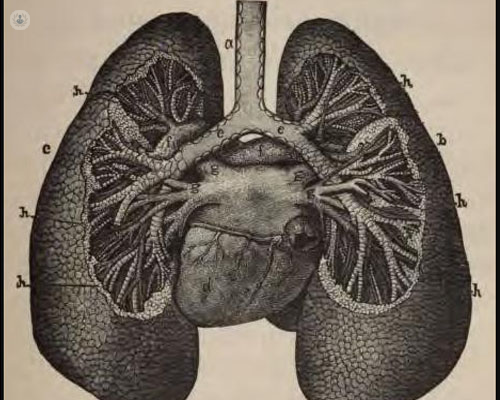Pulmonary emphysema
Written by:What is pulmonary emphysema
Pulmonary emphysema, a term that comes from the Greek that means "insufflation" -flammation of air-is based on changes suffered by the lungs almost always due to the habit of tobacco. In a very schematic way we could say that the lung is constituted by two compartments:
1. The bronchi , which from the trachea are bifurcating successively, up to more than 20 times, of ever finer diameter, up to 1 mm and whose main function is piping for air transport.
2. The alveoli , which are millions of microscopic spherical units as if they were bunches, with very thin walls -much thinner than the thinnest paper- and whose function is to let oxygen out of the air into the capillaries (last and microscopic ramifications of the circulation) pulmonary).
The components of the tobacco either directly by toxic effect or by inflammation, are the cause of the walls of the sockets being "digested", breaking up like soap bubbles or pores of a sponge. This is emphysema.

If we unfolded all the sockets of the healthy lungs like "a drop-down" one obtains a surface the size of a tennis court, thanks to which the surface of the "filter" is very extensive. In emphysema, when the alveoli rupture, the filter surface becomes smaller, decreases, making the transport of oxygen less efficient.
The main symptom is choking when walking especially on slopes and stairs. A healthy person can imagine it by taking a breath, and without taking it out, start running. Many smokers will have had cough and expectoration for years, but have "despised" it as a warning sign.
Diagnosis of pulmonary emphysema
Emphysema is diagnosed with:
1. Laboratory of respiratory function : spirometry, bronchodilator test, plethysmography and diffusion (DLCO). The earliest is the decline of the DLCO.
2. CT scan (chest scan) , since the x-ray is unreliable and too late. Thanks to the three-dimensional reconstructions with TAC we know that emphysema usually starts in the upper regions of the lungs, and goes down. The images mimic the careers of the stockings or the break of a network. Emphysema, at the beginning, is more a warning than a terrible news, but we know that if smoking continues, the bronchial obstruction will advance, causing a decrease in oxygen in the blood (respiratory failure).. A greater amount of accumulated tobacco , greater emphysema, although the relationship is not fully proportional. Ten years of a daily package are enough. Infrequently it can happen that even if tobacco is abandoned, if there has already been a chronic colonization of the bronchi (as "occupies"), the disease does not stop and even progress.
The retained air of emphysema can deform the chest (in the form of a barrel) and I have even seen patients who explain to me that they do not sink in the pool!
Chronic Obstructive Pulmonary Disease (COPD)
Emphysema is a risk factor for lung cancer , and the finding of a lung nodule these patients should be studied immediately.
Emphysema is part of a syndrome we call Chronic Obstructive Pulmonary Disease (COPD). The characteristic of COPD is that the FEV1 / FVC ratio (spirometry parameters) is less than 70%.
The deficit of alpha-1-antitrypsin, which is a rare inherited disease, also produces emphysema. On the contrary, asthma , which also produces bronchial obstruction (without smoking) is not a cause of emphysema.
Emphysema is irreversible and, therefore, the earlier the tobacco is abandoned, the better. What can be improved is obstruction with the use of bronchodilators and anti-inflammatories, and antibiotics. While respiratory failure is treated with oxygen.


